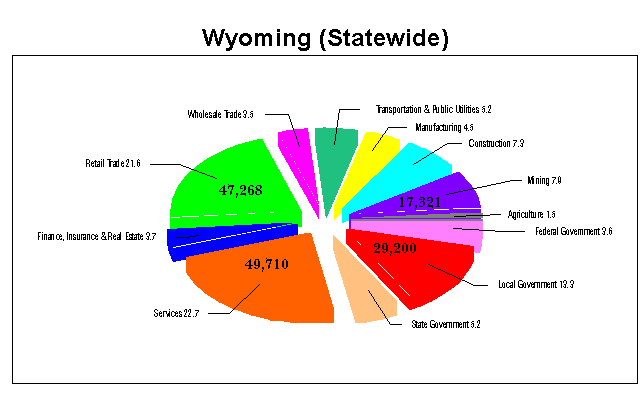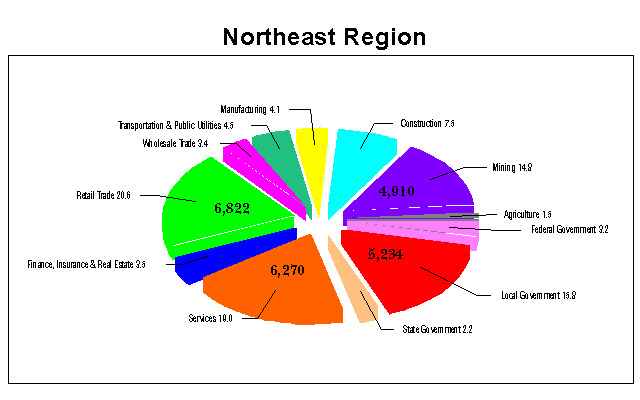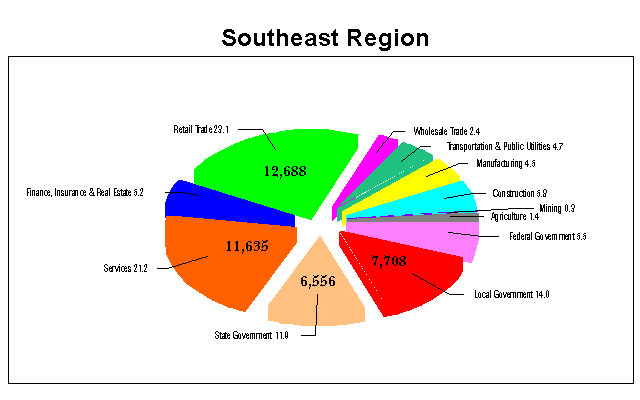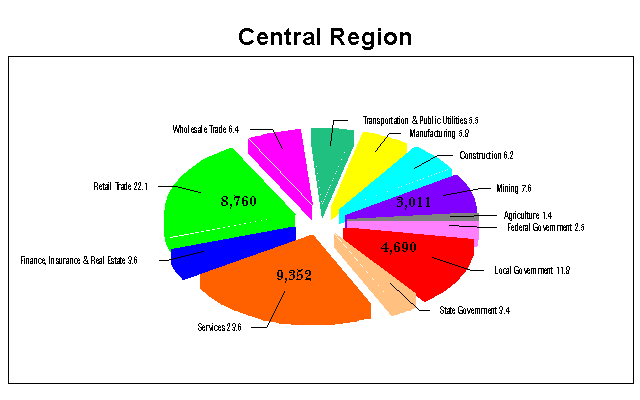
Wyoming is divided into five geographic regions for administrative and Labor Market Information purposes. These are: Northwest Region (Big Horn, Fremont, Hot Springs, Park and Washakie Counties); Northeast Region (Campbell, Crook, Johnson, Sheridan and Weston Counties); Southwest Region (Lincoln, Sublette, Sweetwater, Teton and Uinta Counties); Southeast Region (Albany, Goshen, Laramie, Niobrara and Platte Counties); Central Region (Carbon, Converse and Natrona Counties).
The following Figures were produced using data from the ES-202 (Covered Employment and Wages) for third quarter 1995 (refer to the April issue , "Covered Employment and Wages for Third Quarter 1995 (includes Tables)", for the complete data set. Each Figure includes twelve major industries and the percent of covered employment in each industry; also included are the number of covered workers in the top four industries for third quarter 1995.
|

|
The four largest industries statewide are: Services (22.7%), Retail Trade (21.6%), Local Government (13.3%) and Mining (7.9%). All five of Wyoming's regions include the first three of these in their top four industries, although not all are in the same order. Construction, as was previously noted, is typically in a seasonal high during the third quarter of the year.

|
The Northwest Region of Wyoming has the highest percentage of covered employment in Agriculture in the state (2.5% compared to 1.5% statewide) and the second lowest Mining employment (4.4% versus 7.9%). Of all the regions, the Northwest is the only one that includes Construction in its top four industries; the proportion is 7.9 percent, the same as statewide.

|
The percentage of covered workers in Mining is higher in the Northeast Region than in any other region or statewide; at 14.8 percent, it is nearly double the statewide proportion. Similarly, this region has the highest proportion of Local Government workers (15.8% versus 13.3% statewide). Retail Trade is the top industry in the Northeast Region, followed closely by Services.
|
|
The Southwest Region has the second highest proportion of covered employment in Mining in the state (12.6% compared to 14.8% in the Northeast Region and 7.9% statewide). Construction, Services and Transportation & Public Utilities are proportionately higher in this region than in any other or statewide. However, Agriculture is lower here than elsewhere.

|
The Southeast Region is the only one that includes State Government in its top four industries; the proportion is 11.9 percent, which is double the statewide value and is also higher than any of the other regions. Retail Trade and Federal Government are also higher proportionately in the Southeast Region. On the other hand, Mining is almost non-existent in this region.

|
The top four industries in the Central Region of Wyoming mirror those of the state as a whole. The proportion of covered employment in Wholesale Trade in this region is higher than in any other or statewide. Also, the Central Region ties the Northwest Region for the highest proportion of covered workers in Manufacturing (5.8% each, versus 4.5% statewide).
Beginning with the February issue, TRENDS has been providing a more localized look at Wyoming by using data from the ES-202 (Covered Employment and Wages) program to produce figures such as the preceding for every county in Wyoming, five geographic regions and the state as a whole. If you are interested in obtaining further information about the industries of the counties and regions of Wyoming, as well as those of Wyoming's neighboring states, please contact Valerie Davis (write Research & Planning, P.O. Box 2760, Casper, Wyoming 82602; telephone (307) 473-3807; fax (307) 473-3834) for the new publication An Illustrated History of Employment (1990 & 1994). This publication is available free of charge to Wyoming residents and for a fee of $6 to non-residents.
TRENDS will continue to update our readers with localized information in future issues.
Gayle C. Edlin is a Senior Statistician with Research & Planning and is Editor of TRENDS.
| Table of | Labor Market | Employment | Send Your Comments | |||||||||||||||
|---|---|---|---|---|---|---|---|---|---|---|---|---|---|---|---|---|---|---|
| Contents | Information | Resources | on TRENDS |  |
 |
 |
 |
|||||||||||